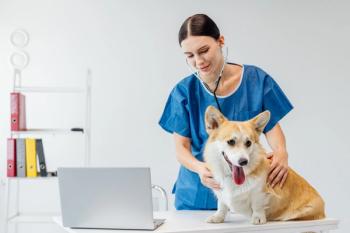
Rehabilitation prognosis positive after TPLO surgery in an agility dog
Editor's Note:Physical therapy and rehabilitation training techniques for dogs is the topic of a new column making its debut this month. DVM Newsmagazine and the American Canine Sports Medicine Association have developed this series to offer practical information for veterinarians when providing rehabilitation services for patients.
Editor's Note:Physical therapy and rehabilitation training techniques for dogs is the topic of a new column making its debut this month. DVM Newsmagazine and the American Canine Sports Medicine Association have developed this series to offer practical information for veterinarians when providing rehabilitation services for patients.
Connie Schulte, PT
Signalment
Kahlar, 8-year-old, spayed female, mixed breed weighing approximately 40 pounds.
History
Kahlar began training agility at the age of 7. She competed in North American Dog Agility Council (NADAC) Veteran's classes. This is a class for dogs 7 years and older. The dog is allowed to jump 4 inches lower and is given an additional 10 percent time allowance to complete the course. She was awarded with the Superior Novice Agility Certificate, Superior Novice Gambler Certificate and the Superior Novice Jumpers Certificate.
Injury
On Sept. 13, 2001, Kahlar came up lame after chasing a ball in the back- yard six days before NADAC Agility Championships for which she had qualified. She was diagnosed with a right craninal cruciate ligament injury and severe bilateral hip dysplasia. She had functioned at a high level with the dysplasia prior to the acute right pelvic limb lameness.
Medical treatment
She was placed on Rimadyl® for two weeks. A tibial plateau leveling osteotomy (TPLO) was performed on Sept. 26. Physical therapy began two weeks later after suture removal.
Physical therapy assessment
Kahlar had significant rear limb atrophy. Left proximal thigh circumference was 36 cm, right 29 cm. She was about 70 percent weight bearing. The goals of physical therapy were to improve weight bearing to normalize gait and decrease atrophy. The ultimate goal was returning this animal to agility competition. Kahlar attended therapy once a week for five weeks, and her owner followed through with home exercises consistently.
Physical therapy treatment
Initial exercises included weight shifting, minitrampoline and rockerboard for proprioception and muscle contraction, stretching into hip extension and abduction, and swimming in a life vest for five minutes. Home exercises consisted of weight shifting, hip flexor and adductor stretching and frequent short walks.
Note lack of extension before injury.
On Kahlar's second visit, sit-to-stand and weight bearing on rear limbs using a 55 cm therapy ball were added. Swim time was increased to 10 minutes. Sit- to-stand was added to the dog's home exercise program (HEP).
During the third session, the stretches were discontinued. Walking in circles, high-stepping over obstacles, and crawling was added to the rest of the previous exercises. Swimming increased to 15 minutes. Dancing was added to HEP.
Inclines were added in the fourth session and swimming was increased to 20 minutes.
In the fifth and final treatment, swimming was increased to 25 minutes.
At discharge, after five visits, weight bearing on the right was 80 percent of the left and thigh atrophy had decreased to only a 2.5 cm. difference in circumference.
Radiographs on Nov. 19 showed bony healing was progressing, Kahlar had minimal to no lameness. In January 2002, Kahlar was released to increase exercise.
Rehabilitation after discharge
Kahlar's daily routine included walking in the morning, exercise in the afternoon and swimming in the evening. She swam in a 150- gallon Rubbermaid stock tank for 30 minutes five to six times per week, progressing from using a life vest to only a harness. She did "lateral" incline walking, i.e. walking back and forth across a hill, 200-600 yards, five to six days a week. Kahlar's owners also encouraged "plowing" when walking on a leash. The leash is held parallel to her body and she was encouraged to pull to strengthen her rear limbs.
Note improved jump position after rehabilitation.
Four months after surgery Kahlar returned to agility training. By late March 2002, she was competing. Since surgery, Kahlar has been awarded Outstanding Open Agility Certificate, Outstanding Open Gamblers Certificate, and Veteran's Open Jumpers. She also earned sufficient points to qualify for the 2002 NADAC Championships.
Kahlar's owners report that since physical therapy, Kahlar's unique rear movement, affectionately referred to as her "funky back end," has been significantly reduced. Her jumping and running ability is improved from the strength she has gained.
Newsletter
From exam room tips to practice management insights, get trusted veterinary news delivered straight to your inbox—subscribe to dvm360.




